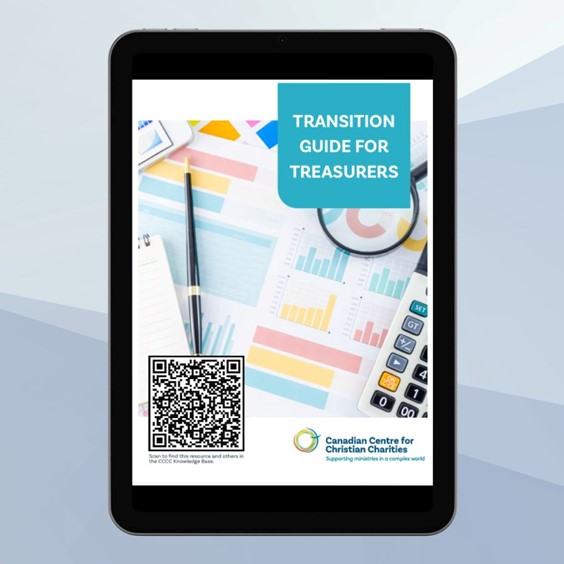“Whoever walks in integrity walks securely, but whoever takes crooked paths will be found out” (Proverbs 10:9, NIV).
A charity should have an appropriate system of internal controls in place to protect itself and its staff from accusations of fraud and to deter internal fraud. This is especially important in a small office setting with fewer staff and fewer opportunities to segregate tasks.
Below are best practices for some of the common areas involving cash and other assets in a typical office environment.
General Controls
- Involve as many people as possible.
- Use only pre-numbered cheques.
- If possible, use accounting software to print cheques.
- Keep all unused cheques in a locked cabinet.
- Limit the number of people with access to the cheques.
- Pay only from invoices. Do not process statements from vendors.
- Mark invoices “paid” to avoid duplicate payments.
- Follow the same procedures for online payments (e.g., PayPal) as cheques.
- Someone other than the person writing the cheque should review the documentation and sign the cheque.
- Require two signatures for amounts above a set threshold.
Writing Cheques
The more people involved in the cheque writing process (i.e., segregation of duties), the less likely a problem will occur. Sometimes, it is best to have board members also be cheque signers. This option is usually most viable if there are several board members living in the area of the charity’s office.
At a minimum, a charity should have two people involved in this process. Here is a breakdown of duties in the cheque writing process:
- The mail is opened by someone other than the bookkeeper and initialled.
- The invoice is checked for accuracy by the bookkeeper.
- Does it add?
- Does it match the packing information if the items were delivered?
- The invoice should be coded by the type of account and department or program of the person who ordered the service and/or is responsible for charging the budget. They should also ensure the price agrees with the original quote or contract.
- The person who authorized the purchase or service should approve the invoice in writing, preferably on the invoice.
- The cheque should be printed by the bookkeeper.
- The unsigned cheque and the supporting documentation should be given to the cheque signer(s) (e.g., manager) to sign and initial documentation.
- The cheques should then be mailed.
- A copy of the cheque or the cheque stub should be attached to the invoice and filed by the bookkeeper.
Electronic Payments
Processing the request for payment is the same whether writing cheques or making online payments; however, the method of making the payment differs. When making an online payment, all of the documentation and authorizations necessary for any disbursement should be obtained and properly authorized prior to making the transfer.
Deposits
Where possible, have an individual outside of the accounting department open the mail. This individual should make a list of the cheques received prior to forwarding the cheques to the accounting department. They should also document what was in the envelope and initial.
If a large amount of cash (as opposed to cheques) is received (for example, from a fundraising event), then two people should always be present when cash is collected and counted.
The organization should have a “For deposit only” stamp. The stamp should also include the organization’s name. Every cheque received should be stamped prior to deposit.
A deposit slip should be prepared, including a listing or tape of all cheque amounts. Copies of the cheques deposited are often kept as support for the deposit. If any correspondence has been received with the cheque, it should also be kept.
Management of the organization should receive regular notification of the amount of the deposits made. If a donor has restricted the usage of the contribution to a particular program, it will be necessary to record the amount as restricted to that program.
Credit Card Transactions
If given the option, many people will opt to use their credit card to make a donation or to pay a fee for a service or publication. The convenience associated with the transaction helps to facilitate the interaction with the charity. Fees will be charged to the charity for the transaction, but the percentage charged varies by credit card company.
As online transactions become more prevalent, many charities are choosing to have all online-generated transactions sent directly to credit card companies. In this scenario, the credit card company receives the transaction directly, processes the transaction upon receipt, and transmits the deposit to the charity’s bank account.
A report is sent electronically to notify the charity of the activity, and a paper summary of the transactions is sent periodically.
Sending Invoices
Invoices may need to be prepared for a number of reasons. Some charities sell books or other publications for a fee. Others require registration for conferences or bill for membership fees. In any event, all invoices should be reviewed by a person other than the preparer before mailing. Copies of all paid and unpaid invoices should be kept.
An aging list should be kept; that way, the amount of time it takes for an invoice to be paid can be tracked. Also, collection efforts can be started in a timely fashion.
If it is later determined that an amount will not be collected, the invoice and corresponding revenue should be written off. All amounts written off should be approved in writing by management.
Bank Reconciliations
Management (e.g., treasurer or accountant) should receive the unopened bank statement each month. This individual should review all activity and be confident that all transactions are valid. The reviewer should initial the bank statement indicating their review. Once the review takes place, the bookkeeper should reconcile the account.
The process explained above could be reversed. The bookkeeper could reconcile the bank and then have the treasurer review and sign off.
Petty Cash
Only one person should have access to the petty cash fund. At all times, the cash and the receipts signed for withdrawals should equal the fund’s total in the general ledger. The cash should be in a locked box and kept in a secure drawer or filing cabinet.
Every time an individual receives cash from the box, a voucher should be signed and placed in the box. The expense coding should be noted on the voucher. If a receipt is obtained for the purchase of supplies, this receipt should be attached to the voucher.
When the cash in the box runs low, the total of the vouchers should be determined, and a cheque should be written for that amount. The cheque should be made payable “cash” or to the individual in charge of the petty cash.
A summary of the expenses noted on the vouchers should be prepared and attached to the cheque copy. This summary will be the basis for recording the activity in the general ledger. Under no circumstances should the petty cash fund be used to advance monies to employees in the form of loans.
Credit Cards Held by Staff
The use of charity credit cards held by staff should be limited to those who need to make payments online or away from the office. Proper backup and authorization should always be obtained. Personal expenses should never be charged on ministry credit cards.
Time Sheets
Salaries are generally a charity’s largest expense. Allocating this expense to the various functions on an equitable and consistent basis is the key to properly reflecting the activity of the charity.
Time sheets are the most accurate method of allocating salary expense. Timesheets should be submitted by all employees for each pay period. Timesheets should also be used to monitor vacation, sick leave, and other time off.
All time sheets should be approved by a supervisor. Approval should also be noted on the actual time record if any changes are made. The calculated amounts are then posted to the general ledger.
Furniture & Equipment Assets
Depending on the size of the charity, most of the furniture and equipment purchased are considered assets and not expenses. Once an asset is recorded, its useful life is determined. A portion of the asset’s cost is then expensed each year over the predetermined useful life and allocated to a contra account called “accumulated depreciation.”
The charity should establish a “capitalization policy.” All items above a set amount are treated as assets, while items with a cost below the threshold are expensed when purchased. A limit of $300 to $500 might be appropriate for small charities.
Periodic reviews of the fixed assets should be made to verify the list matches the actual items owned and used.
Expenses
Charitable organizations are required to track expenses by object and/or by function. Object categories include salaries, payroll taxes, rent, professional fees, utilities, office supplies, etc.
Functional categories include various programs, as well as administrative and fundraising expenses. Most charities have more than one program and each of these should be tracked separately.
Financial Reporting
It is important to report the charity’s financial position to the board of directors periodically and to management monthly.
During the year, a statement of activities noting the actual revenue and expenses for the month and year-to-date should be compared to the budgets prepared for the comparable periods. Any variances from expectations should be noted and explained.
Monitoring of the financial position of the organization in relation to the budget will allow management or the board of directors to take action if, for example, revenues are not sufficient to meet the projected expenses for the year. Early intervention can be taken to find other revenue sources or to cut costs.
Conclusion
There is no absolute guarantee that your charity will be immune to fraud; however, with the appropriate controls in place, even a small charity can have confidence that it is putting deterrents in place to protect itself from the risk of fraud.
Looking For More Support?
Are you “passing the baton” and making a role transition in your ministry in the area of financial administration? Whether you are a treasurer of an agency which uses a policy governance model or a church treasurer with more administrative responsibilities, the transition from one treasurer to another is important.
Download our free “Transition Guide For Treasurers” Here.

Just for CCCC members!
CCCC members have access to sample documents and resources in the Knowledge Base, including:
Church Collections: Counting, Deposit and Financial Control
Books and Records Requirements
Record Retention Periods Checklists
Plus, CCCC members can contact our Member Support Team with questions related to finance or other aspects of running a charity. Our credentialed specialists love to hear from members and guide them to solutions.
Not yet a CCCC member? We’d love to welcome you into membership and provide you with the support your ministry needs to thrive! Join Here.


